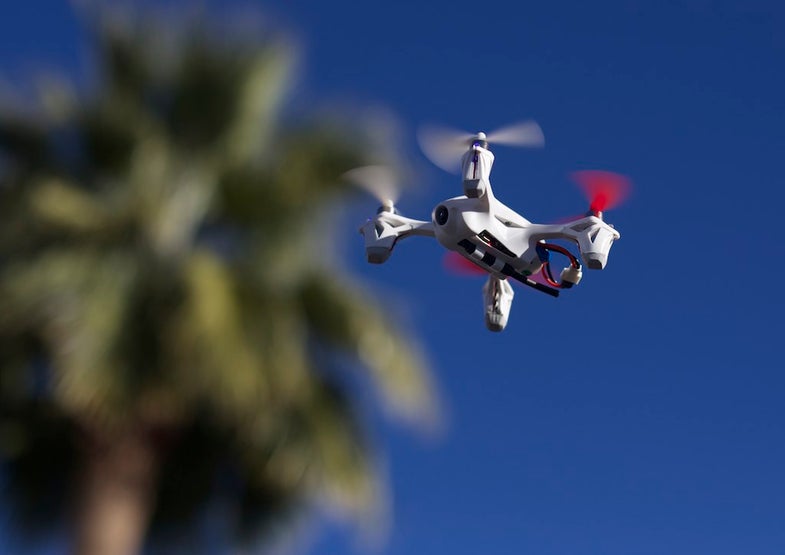Report: 96 percent of pilot-reported drone sightings are totally benign
Close encounters of the drone kind are rarer than they seem

The Federal Aviation Administration exists to keep the skies safe for people. In the past two years, that task has grown much more complex. The FAA added an unprecedented number of new pilots: 770,000 registered drone operators, which is almost 200,000 more than the 584,000 total pilot certificates held in 2016. As one might expect, that massive increase in people operating flying machine is accompanied by a jump in how many pilots saw strange airborne objects.
What didn’t change, even as hundreds of thousands of drones joined the skies over the United States, is the number of dangerous close encounters with drones. The Academy of Model Aeronautics (AMA), a hobbyist organization founded in 1936, today published a report examining the reported close calls between drones and crewed aircraft. Looking at data collected and published by the FAA, the AMA report found that, out of a dataset of 1,270 drone sightings released in February 2017, only 44 of those encounters, or 3.4 percent, were near misses or close calls. Further, this is consistent with data provided in 2016 and 2015, where the number of closes calls hovered between 3.3 and 3.5 percent of the total reports.
“Back in the 70s and 80s, everything pilots saw was a UFO. Now everything they see is a drone,” laughed Richard Hanson, President of the Academy of Model Aeronautics. “Drones are the new UFOs.”
These reports come from pilots, and one possibility is that in the 2010s pilots are using “drone” to refer to any airborne thing they couldn’t quite discern, the way pilots in the past referred to such sightings as UFOs. Besides drones, objects pilots reported to the FAA and in the sightings data include balloons, birds, kites, parasails, and even a “blob.”
In 2015, when the FAA first released this data, they did so under the headline “Pilot Reports of Close Calls With Drones Soar in 2015“, a rhetorical leap that conflates the mere sighting of a drone with reckless endangerment of an aircraft. As the AMA found when looking through the data, many of the drone sightings described perfectly lawful behavior, like flying a quadcopter at 200 feet, well below the 400-foot ceiling required by registered drone pilots under FAA rules. Manned aircraft typically fly at 500 feet or above, so drones operating at 400 feet and below provide a 100-foot buffer in the sky.
Hanson credits programs like the AMA’s “Know Before You Fly” campaign and education outreach with keeping the percentage of actual close calls so low. (The “Know Before You Fly” campaign was co-founded by the AMA and the Association for Unmanned Vehicle Systems International).
“The most effective means of addressing this issue is education,” said Hanson. “The vast number of sightings that are people operating inappropriately is because they just don’t know any better, they didn’t know they weren’t supposed to do what they were doing. There are a few individuals who are irresponsible but you find that in any community of people.”

1/3 Scale Sopwith Pup
Flying model airplanes as a hobby dates back to the earliest years of flight, and was by and large something governed by community and hobbyist organizations. With the advent of cheap drones, congress asked the FAA to adapt its model airplane guidelines to drone laws, a process that’s taken years. The AMA has grown into this space, advocating for the rights of both traditional model airplane fliers and newer recreational users, who may buy a quadcopter as a flying selfie stick and don’t quite fit the traditional hobbyist model.
Beyond the enjoyment of the present community of users, Hanson sees model airplanes and drones as a vital part of the aviation industry pipeline.
“Drones are a perfect storm of activity to get people engaged in this industry with its combination of aeronautics aspect, a computer science aspect, and robotics in there,” said Hanson, “All throughout the country we use model aircraft and drones as teaching tools for STEM curriculums.”
But if everyone who sees a drone reports it as a danger, even if the user is operating it correctly, it’s harder to get people into the hobby, and it makes limits how law-abiding drone pilots can use their flying machines. This is part of the impetus behind the AMA’s analysis of the FAA report.
“We have been encouraging the FAA to do their own analysis before they put the data out there so they can put it in context and perspective,” said Hanson, “but I’m sure they have limited resources to do that, so while they’re not doing it, we’ve taken it upon ourselves to go through these reports and actually do an analysis with context and perspective.”
